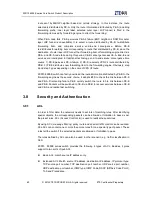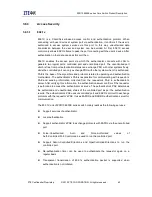
ZXR10 8900E series Core Switch Product Description
52
© 2013ZTE CORPORATION. All rights reserved.
ZTE Confidential Proprietary
3.7.5
L3 route protection
3.7.5.1
Enhanced VRRP
If traditional VRRP technology is adopted, when router link goes wrong or powers off,
backup router spends 3 seconds in switching, which cannot address the user demands
when IP network bears voice service. Enhanced VRRP introduces fast BFD mechanism
to replace VRRP heartbeat message. It speeds up the detection between VRRP entities
and employs single-hop or multi-hop BFD to check whether the real-address
communication between slave and master routers is normal. If not, the slave will consider
the Master is unavailable and upgrade to the master to fulfill fast switching.
VRRP and BFD are bound based on BFD session between router and host, which means
that master and slave routers are respectively bound to different BFD-sessions (These
sessions are not established between master and slave routers). If the communication is
abnormal between master router BFD and HOST, VRRP downgrades master to slave,
and upgrades slave to master to link the communication between protection router and
host and fulfill fast switching between master and slave routers.
Furthermore, ZXR10 8900E supports VRRP group management. Multiple VRRPs forms
a VRRP management group, and each member keeps consistent with the group in the
status. When VRRP management group creates a BFD session to trigger management
group status switching, all members will make status switching. VRRP group
management reduces inter-equipment BFD message traffic to facilitate VRRP
management and bring down network and equipment load.
3.7.5.2
Route Load balance
Load balance helps the equipment to forward the traffic via several activated links so as
to make full use of the bandwidth of these links. Load balance does not mean that the
traffic of one link is equal to the other.
By configuring static route, route protocol and route number, ZXR10 8900E adopting
route-based load balance sets several reachable routes to one destination address in the
forwarding table so as to offer the basis for load balance.
The route technology for load balance includes ECMP (Equal-cost multi-path routing) and
WCMP (Weight-cost multi-path routing). ECMP working principle is: When there are
several paths reachable to one destination address in the network, the data is transmitted
via several links. ECMP makes full use of the bandwidth of idle links and backs up data
transport of failed links. WCMP improves ECMP. Because the links are different from
each other in the bandwidth, if the data is averaged to the links to transport, it is
impossible to make full use of the link with larger bandwidth. Therefore, WCMP adjusts
the route weights according to a policy to make ECMP more flexible and practical.
Summary of Contents for ZXR10 8900E series
Page 1: ...Operator Logo ZXR10 8900E series Core Switch Product Description ...
Page 2: ......
Page 10: ......
















































